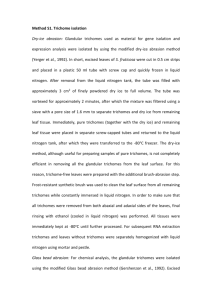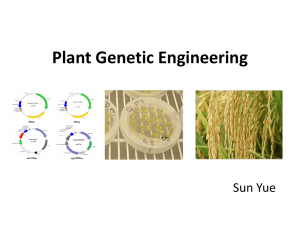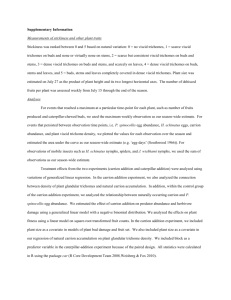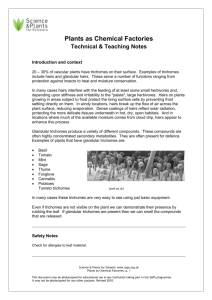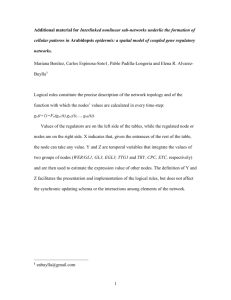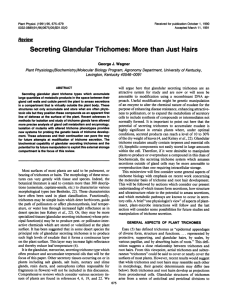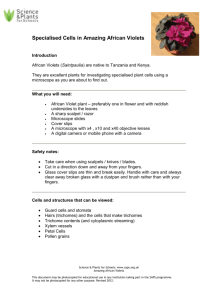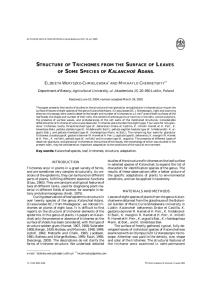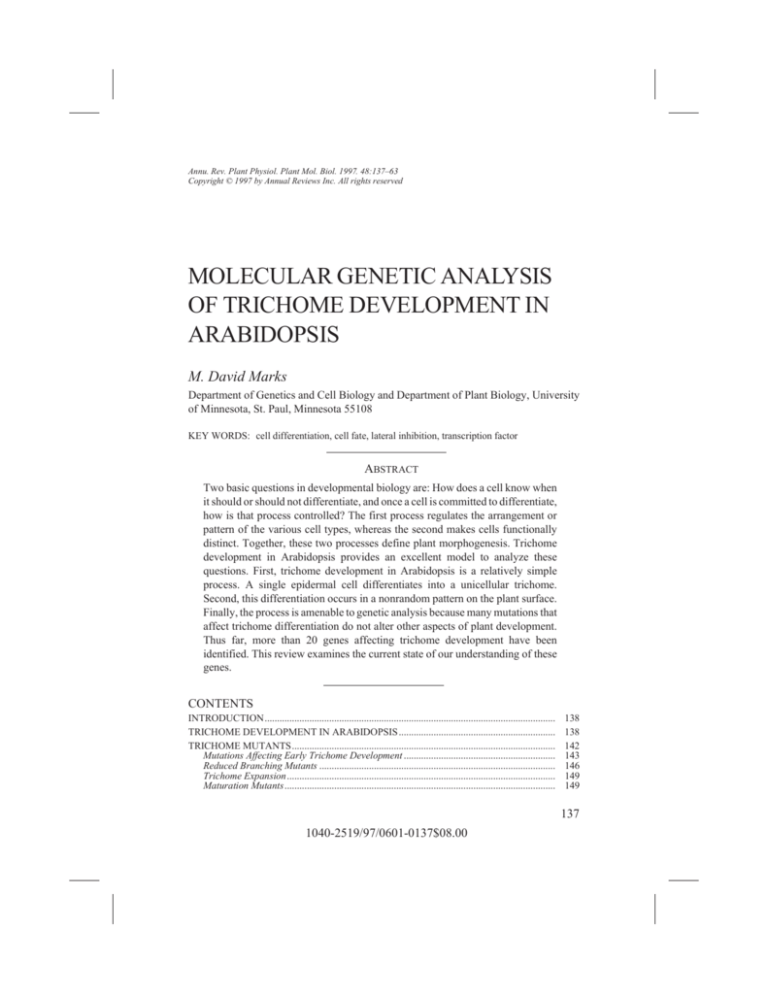
TRICHOME DEVELOPMENT IN ARABIDOPSIS
MARKS
Annu. Rev. Plant Physiol. Plant Mol. Biol. 1997. 48:137–63
Copyright © 1997 by Annual Reviews Inc. All rights reserved
MOLECULAR GENETIC ANALYSIS
OF TRICHOME DEVELOPMENT IN
ARABIDOPSIS
M. David Marks
Department of Genetics and Cell Biology and Department of Plant Biology, University
of Minnesota, St. Paul, Minnesota 55108
KEY WORDS: cell differentiation, cell fate, lateral inhibition, transcription factor
ABSTRACT
Two basic questions in developmental biology are: How does a cell know when
it should or should not differentiate, and once a cell is committed to differentiate,
how is that process controlled? The first process regulates the arrangement or
pattern of the various cell types, whereas the second makes cells functionally
distinct. Together, these two processes define plant morphogenesis. Trichome
development in Arabidopsis provides an excellent model to analyze these
questions. First, trichome development in Arabidopsis is a relatively simple
process. A single epidermal cell differentiates into a unicellular trichome.
Second, this differentiation occurs in a nonrandom pattern on the plant surface.
Finally, the process is amenable to genetic analysis because many mutations that
affect trichome differentiation do not alter other aspects of plant development.
Thus far, more than 20 genes affecting trichome development have been
identified. This review examines the current state of our understanding of these
genes.
CONTENTS
INTRODUCTION.....................................................................................................................
TRICHOME DEVELOPMENT IN ARABIDOPSIS ...............................................................
TRICHOME MUTANTS..........................................................................................................
Mutations Affecting Early Trichome Development .............................................................
Reduced Branching Mutants ...............................................................................................
Trichome Expansion............................................................................................................
Maturation Mutants.............................................................................................................
138
138
142
143
146
149
149
137
1040-2519/97/0601-0137$08.00
138 MARKS
Genetic Interactions ............................................................................................................
MOLECULAR STUDIES.........................................................................................................
GL1 ......................................................................................................................................
TTG......................................................................................................................................
Interactions Between GL1 and TTG....................................................................................
GL2 ......................................................................................................................................
ZWI ......................................................................................................................................
Other Genes.........................................................................................................................
CONCLUSIONS AND FUTURE DIRECTIONS....................................................................
151
151
151
153
155
156
157
158
159
INTRODUCTION
Most higher eukaryotic organisms begin life as a single-celled zygote. During
organismal development this cell divides, and the resulting progeny differentiate and acquire special functions. In many plants, the first division of a zygote
results in two cells with different fates. One cell will form the suspensor, and
the other cell will produce the embryo proper. Much later, divisions of protodermal cells in leaf primordia generate daughter cells that differentiate into
vastly different cell types. Thus, from the first to the terminal cell divisions of
plant development, control of cell fate is important.
The development of plant leaf hairs, trichomes, provides an excellent system to study the control of cell fate (24, 49, 61–63, 76). First, trichomes
develop on the epidermal surface, and all phases of trichome development can
be observed. Second, development of trichomes is a relatively simple process.
A single epidermal cell differentiates into a single-celled trichome. Third, the
development of trichomes can be genetically dissected because normal plant
growth and development do not require the presence of trichomes. Finally,
understanding trichome development may have practical implications because
there is a correlation between the presence of trichomes and resistance to
herbivory by certain insect pests (1, 27, 37, 39, 44–46, 53, 68). The genetics of
trichome formation has been studied in other plant species (4, 19, 28, 40, 41,
52, 81), but this review focuses on Arabidopsis.
TRICHOME DEVELOPMENT IN ARABIDOPSIS
Trichomes are normally present on the leaves, stems, and sepals of Arabidopsis (Figure 1A, B, C). They are normally absent from the roots, hypocotyl,
cotyledons, petals, stamens, and carpels. The morphology of trichomes varies
from unbranched spikes, which are most commonly found on the stems and
sepals, to structures containing two to five branches, which are found on the
leaves. Most trichome mutations affect all of the trichomes on a plant. This
Figure 1 Trichomes on Arabidopsis seedlings. (A) Leaf trichomes. (B) Stem trichomes. (C) Sepal trichomes. Arrows denote trichomes.
TRICHOME DEVELOPMENT IN ARABIDOPSIS
139
140 MARKS
suggests that while different trichomes may have different morphologies, their
development is controlled by the same genes.
Trichome development proceeds as a wave across the epidermal surface on
the leaf (31, 60). The first trichome initiates on the tip of the adaxial surface of
the first primordium after it achieves a length of approximately 100 µm (47).
As trichomes mature at the leaf tip, new trichomes emerge progressively
toward the base (Figure 2A). In addition, new trichomes initiate in between
developing trichomes that have been separated from one another by dividing
Figure 2 Trichome development on Arabidopsis leaves. (A) Scanning electron micrograph (SEM)
of a young leaf with mature and developing trichomes. Thick arrow denotes developing trichome;
thin arrow denotes mature trichome. (B) Section through emerging trichome. Arrow denotes
enlarged nucleus. (C) SEM of developing trichomes. Arrows denote expanding branches. White
bars indicate approximately 12 µm.
TRICHOME DEVELOPMENT IN ARABIDOPSIS
141
epidermal cells. Trichome initiation is found only in regions where epidermal
cell division is occurring.
The first detectable step in the commitment to the trichome cell fate is a
cessation of cell division; however, nuclear DNA synthesis continues, and the
committed cell undergoes at least two rounds of endoreduplication, reaching at
least 8N (Figure 2B) (31, 69). Cells surrounding a committed cell continue to
divide normally. After the committed cell radially expands to a diameter that is
approximately twofold greater than the surrounding cells, it begins to expand
preferentially on its outer surface to form a stalk (Figure 2C) (60, 64). As the
stalk forms, diffuse growth throughout the cell results in continued radial
expansion. The nucleus migrates into the aerial portion of the stalk shortly
before secondary protuberances (31), which subsequently expand into the
branches, emerge from the aerial tip (Figure 2C). During branch formation, the
nucleus undergoes another round of endoreduplication and migrates to the
base of the last branch that forms (31). Expansion ceases when a trichome
reaches a height of 200–300 µm and a base diameter of approximately 50 µm.
During trichome maturation the cell wall thickens to approximately 5 µm, and
the trichome surface becomes covered with papillae. In addition, the epidermal
cells around the base of a trichome acquire a distinct rectangular shape. It
appears as though the trichome base often pushes under the surrounding epidermal cells to create a socket. Thus, the surrounding cells are sometimes
referred to as socket cells (31).
Detailed cellular analysis of Arabidopsis trichome development has yet to
be completed. Thus, little is known about the role of the endomembrane
system or cytoskeleton in trichome morphogenesis.
Trichome development has been used as a marker for leaf heteroblasty (85).
Differences in trichome shape and position can be observed in a comparison of
the initial and later leaves. The first two to three leaves have adaxial trichomes
but lack trichomes on their abaxial surfaces. Later rosette leaves have an
increasing number of abaxial trichomes. This progression continues on the
bract-like leaves on the stem. The first bracts have trichomes on both adaxial
and abaxial surfaces; however, later bracts have diminished numbers of
adaxial trichomes, while maintaining their abaxial trichomes.
Trichomes are evenly distributed across the leaf surfaces, but contiguous
trichomes are rarely observed. This type of arrangement has been described as
an isotropic pattern (25). A statistical analysis of trichome spacing has shown
that it is nonrandom (47), that is, it is statistically significant that no trichomes
are contiguous. The parameter R was set as a ratio between the measured
average distances between nearest neighbor trichomes on the leaf surface and
the average nearest neighbor distance expected for a random pattern with the
142 MARKS
same density (5). A random pattern would have a value of R = 1, whereas a
maximum spacing arrangement (i.e. all trichomes equal distance from one
another) would result in R = 2.15. A value of R = 1.40, which represents a
significant deviation from a random distribution, was observed [P < 0.01 (47)].
This indicates that there is a minimum distance between trichomes.
To study the development of the trichome pattern, the frequency and spacing of initiating trichomes were statistically analyzed (47). In a sample of 2120
epidermal cells on young leaf primordia, it was found that the fraction of cells
that commit to the trichome pathway was 0.041. With this population size, if
trichome initiation was stochastic, then 16 neighboring trichomes should have
been observed. Because none was observed, the probability that trichome
initiation was a random event in this trichome sample was less than 10−8.
Because plant cells do not migrate, there are two main ways in which a
nonrandom pattern can be generated. First, it is possible a trichome and the
cells that surround it are derived from the same cell lineage, and only one cell
in the group becomes a trichome; after this cell differentiates continued epidermal cell divisions would always separate developing trichomes. A second
patterning mechanism requires cell-to-cell communication. A sectorial analysis was used to analyze the mechanism controlling trichome spacing (47).
Plants containing a GUS reporter gene that had been inactivated by a maize Ac
transposon were used. The GUS coding sequence was under the control of the
CaMV 35S RNA promoter; Ac transposition during early plant development
would result in a large clonal sector of GUS positive cells (51). To test the
hypothesis that trichome spacing is controlled by cell lineage, trichomes that
developed along the border of GUS positive sectors were analyzed. No evidence for a cell lineage associated with trichomes was found. Thus, apparently
trichome spacing is controlled by a mechanism involving cell-to-cell communication.
TRICHOME MUTANTS
Mutations affecting trichome initiation, spacing, density, and shape have been
recovered. Some of the mutations affect nontrichome developmental processes. Trichome mutants were first used as convenient genetic markers. The
glabrous1 (gl1) mutant, which lacks trichomes on most surfaces, was used in
early gene mapping studies (67). In 1978 distorted1 (dis1) and distorted2
(dis2) mutants, which have defects in trichome cell expansion, were used to
map genes to chromosome 1 (13). In 1982 trichome mutants were used to
calculate mutation frequencies generated using several different mutagens
(43). In 1988, a review by Haughn & Somerville (24) first documented the
TRICHOME DEVELOPMENT IN ARABIDOPSIS
143
possible use of trichome mutants as a model to address questions concerning
cell fate and differentiation. In 1994 Hülskamp et al described many new
trichome mutants that were recovered from a saturation screen (31). Several
other recent reports also describe the characterization of new trichome mutants.
Mutations Affecting Early Trichome Development
The recessive gl1 and transparent testa glabra (ttg) mutations have the most
dramatic affect on trichome formation (42, 43). Strong loss-of-function mutations in either gene results in a complete loss of trichome formation on most
aerial surfaces (Figure 3A). The gl1 mutation only appears to affect trichome
development; however, the ttg mutation has several developmental consequences. ttg plants lack anthocyanin pigments, which causes ttg seedlings to
lack red pigments and seeds to be yellow instead of reddish brown. ttg mutant
seeds also lack the polysaccharide mucilage that accumulates in the outer layer
of the testa. Aside from the lack of mucilage and normal pigmentation, the ttg
seed coat develops normally. Finally, ttg mutants produce ectopic root hairs
(18). The root epidermis of Arabidopsis normally contains two types of cell
files. In one file all cells are root hairs, and the cells are slightly less elongated
than the cells in the other file type, which contains only nonhair cells. In a ttg
root, the cell files that normally produce root hairs are unaltered. However, the
cells in files that are normally hairless assume the less elongated shape of hair
cells and most, but not all, of the cells in these files form hairs (18).
The loss of trichome initiation is not complete in either mutant. Both gl1
and ttg mutants have a few trichomes on the margin of the rosette and cauline
leaves (Figure 3B). In addition, ttg plants often have trichomes near the leaf
margin of the adaxial surface (Figure 3C). Apparently the marginal trichomes
are controlled by genes other than GL1 or TTG (74). Mutations that result in a
loss of the marginal trichomes have not been described. Other mutations that
affect trichome morphology also affect the morphology of the margin trichomes (MD Marks, unpublished data). Therefore, many genes aside from
GL1 and TTG are active in both margin and nonmargin trichomes.
Weak alleles of both gl1 and ttg have been identified. gl1-2 plants exhibit a
partial loss of trichomes, with a marked reduction of trichomes in the midvein
region (12). Trichome differentiation is altered because many of the leaf trichomes only form rudimentary spikes. In addition, the trichome spacing pattern is altered in that side-by-side rudimentary trichomes are not uncommon.
Several weak alleles of ttg have been identified (48). ttg-10 plants exhibit
clusters of normal and rudimentary trichomes along the leaf margin. Interestingly, the ttg-10 mutation does not affect all the developmental processes that
Figure 3 Loss of trichomes on glabrous mutant class. (A) gl1 mutant seedling. (B) Trichome on leaf margin of ttg mutant seedling. (C) SEM of developing
leaf on ttg seedling. White bar indicates approximately 12 µm.
144 MARKS
TRICHOME DEVELOPMENT IN ARABIDOPSIS
145
normally are altered in ttg mutants. ttg-10 plants lack testa pigmentation, but
they appear to exhibit normal seedling pigmentation, and their seeds develop
mucilage.
Mosaic analysis has been used to determine that the GL1 gene appears to
act cell autonomously. Rédei exposed seeds from a GL1/gl1 heterozygous
plant to X rays (80). He subsequently identified glabrous sectors on the resulting plants. More recently, heterozygous seeds were treated with EMS, and the
resulting plants produced glabrous sectors that were not seen on wild-type
plants (31). The glabrous patches are thought to result from GL1 marker loss,
uncovering the gl1 mutant allele in heterozygous plants. The presence of
sectors indicates that cells outside the sector cannot provide a diffusable substance or signal to overcome the effect of the gl1 mutation.
It was noted that the leaves of Landsberg erecta (Ler) plants contained
fewer trichomes than the leaves of Columbia (Col) plants [Ler ∼10 vs Col ∼30
on the first leaf (63)]. Using the Lister & Dean recombinant inbred mapping
lines (55), which were generated with Ler and Col parents, it was possible to
use quantitative trait analysis to map the loci responsible for the differences in
trichome density (47). One major locus accounts for 73% of the variance and
maps in the region between the markers erecta and m220 on chromosome 2
(LOD score: 27.54). This locus has been named REDUCED TRICHOME
NUMBER (RTN). The RTNCol allele exhibits incomplete dominance over the
RTNLer allele, because F1 hybrids have an intermediate number of trichomes
on first leaves.
Apparently RTN controls the persistence of trichome initiation (47). A
comparison of trichome initiation on plants carrying the Col or the Ler alleles
revealed that trichome initiation begins on the first leaf primordia after a length
of ∼100 µm is reached. As the leaf primordia increased from 100 µm in length
to 300 µm, equal numbers of trichomes were initiated in each background.
However, Ler leaf primordia longer than 300 µm rarely initiated new trichomes, whereas Col leaf primordia over 800 µm long continued to initiate
new trichomes.
There are several modes by which RTN could influence the timing of
trichome initiation (47). It is possible that RTN increases the area of lateral
inhibition around initiating trichomes. This seems unlikely because the distance between the early initiating trichomes on both Col and Ler leaves are
roughly the same. More likely is the possibility that RTN is involved in
controlling either the length of time during which epidermal cells are competent to respond to a trichome-inductive signal or the length of time they are
able to produce the inductive signal. For example, if TTG and/or GL1 expression results in an inductive signal for trichome initiation, then RTN could be
146 MARKS
involved in the transduction of the signal or in positively or negatively regulating the timing of TTG and/or GL1 expression. The incomplete dominance of
the Col allele over the Ler allele suggests that the level of RTN expression is
important. It also is possible that several closely linked genes influencing
trichome density are located in the RTN region.
Recessive mutations in the GLABRA2 (GL2) gene disrupt normal trichome
morphogenesis (43). Two classes of trichomes develop on gl2 mutants. One
class of trichomes has a rudimentary spike that projects upward (Figure 4A).
Toward the margin of gl2 leaves, trichomes are more normal in appearance;
however, these trichomes are less branched than normal. Mosaic analyses
suggest that GL2 acts cell autonomously (31). Mutations in GL2 also affect
other developmental processes. Like ttg, gl2 mutants lack seed coat mucilage
and produce ectopic hairs in the root (43, 66). However, there is a morphological difference in the root hair phenotype between the two mutants. Normally,
hair-bearing cells are shorter than nonhair cells. In ttg mutants, all the root
epidermal cells assume the morphology of the hair cells and many produce
hairs. In contrast, while all the epidermal cells in a gl2 mutant can produce
hairs, the files of cells that normally would not become hairs maintain a more
expanded shape.
Recessive mutations in the GLABRA3 (GL3) gene have two effects on
trichome development (43). On early leaves there is a decrease in trichome
initiation (Figure 3B). As in gl2 mutants and weak gl1 and ttg mutants, the loss
of trichome initiation is most striking in the midvein region of the leaves.
However, on later leaves trichome initiation is more uniform. The trichomes
that do develop tend to be less branched and are more slender than normal. In
addition, it has been observed that trichomes in gl3 mutants undergo fewer
rounds of endoreduplication than wild-type trichomes (31).
Mutations in either the TRYPTYCHON (TRY) or KAKTUS (KAK) genes
result in larger than wild-type trichomes with increased branch formation (31).
Trichomes on these mutants also exhibit an increase in endoreduplication. It
has been reported that try mutants have a greater number of clustered trichomes than are found on wild-type plants (31). Thus, TRY also may be
involved in controlling the proposed lateral inhibition pathway.
Reduced Branching Mutants
Several recessive mutations appear to reduce trichome branching without affecting trichome initiation. Hülskamp et al divided branching into a primary
phase that generates the first branch and a secondary phase that generates
subsequent branches (31). The stichel (sti) mutation eliminates both of these
TRICHOME DEVELOPMENT IN ARABIDOPSIS
147
Figure 4 Trichomes on gl2 and gl3 mutants. (A) SEM of mature trichome on gl2 mutant leaf. (B)
SEM of developing trichomes on young gl3 mutant leaf.
148 MARKS
phases (31). Leaf trichomes on sti mutants are long, unbranched structures
similar to the trichomes found on the stem (31). The trichomes on stachel (sta)
mutants appear to have skipped primary but not secondary branching (31).
These trichomes generally have two branches on top of a long stalk. In contrast, trichomes on both the zwichel (zwi) and angustifolia (an) mutants appear
Figure 5 SEM of zwi mutant trichomes. (A) SEM of young leaf on zwi mutant. (B) SEM of
emerging trichomes on zwi leaf. White bars indicate approximately 12 µm.
TRICHOME DEVELOPMENT IN ARABIDOPSIS
149
to undergo only primary branching (31, 43). Trichomes on both of these
mutants generally have two branches that originate from a region close to the
trichome base (Figure 5). A mosaic analysis suggests that AN acts cell autonomously (31). In an plants the leaves are narrow and the stems and siliques are
twisted.
Trichome Expansion
General trichome expansion is affected by mutations in eight different genes.
These recessive mutations include dis1 and dis2 as well as gnarled (grl),
klunker (klk), spirrig (spi), wurm (wrm), crooked (crk), and alien (ali) (13, 31).
Trichomes on these mutants exhibit irregular expansion (illustrated by the
developing trichomes on the dis2 mutant shown in Figure 6). Because these
mutants do not display other obvious phenotypes, the genes defined by these
mutations may be involved in expansion processes that are unique to trichomes. Alternately, these genes may encode products important for general
cell expansion, but may be members of gene families that are expressed in
various cell types. As might be expected for this class, mosaic analysis indicates that DIS2 appears to act cell autonomously (31). In contrast, the same
analysis indicates that DIS1 may act through a noncell-autonomous mechanism because EMS-treated plants lacked dis1 trichome sectors. As a control,
the heterozygous dis1 plants were also heterozygous for the an mutation, and
an trichome sectors were identified.
The singed (sne) mutation also results in a general alteration of trichome
cell expansion (62). The trichomes appear to develop normally, but the trichome stalk and branches are slightly twisted. In addition, this mutation also
causes a shortening of the root hairs.
Maturation Mutants
Several recessive mutations appear to alter the final stages of trichome development. The under developed trichome (udt) mutation results in trichomes that
are slightly more slender than wild-type and that produce underdeveloped
papillae toward the tips of the branches (24). Three other mutations, chablis
(cha), chardonnay (cdo), and retsina (rts), result in trichomes that lack the
rough papillate surface of wild-type mature trichomes (31).
Potikha & Delmer used an elegant screen to isolate a mutant deficient in
secondary cellulose deposition in trichome cell walls (77). Trichomes exhibit
strong birefringence under polarized light, a characteristic of cell walls containing large amounts of highly ordered cellulose microfibrils. They identified
the recessive trichome birefringence (tbr) mutant that lacks birefringent tri-
150 MARKS
Figure 6 SEM of developing trichomes on dis2 mutant seedling. (A) SEM of dis2 leaf with mature
and developing trichomes. (B) SEM of emerging trichomes on dis2 leaf. White bars indicate
approximately 12 µm.
TRICHOME DEVELOPMENT IN ARABIDOPSIS
151
chomes. Mature tbr trichomes were essentially wild-type in shape, but had a
smooth surface instead of the wild-type rough papillate surface. Quantification
of cellulose in trichomes isolated from wild-type and tbr plants indicated that
tbr trichomes have 18% of the cellulose normally found in wild-type trichomes. The tbr mutation also may result in a reduction of cellulose in the
xylem.
Genetic Interactions
Classical genetic analyses indicate that the gl1 and ttg mutations are epistatic
to all other known trichome mutations. Plants doubly mutant for gl1 or ttg and
other trichome mutants are glabrous. The genetic relationship between gl2,
gl3, and try has also been analyzed (MD Marks, unpublished data; 31). The
gl3/try double mutant has gl3-like trichomes, but retains the clustering phenotype of try. This suggests that GL3 functions downstream of TRY for branching, and that the wild-type function of TRY may be to inhibit branch formation
by directly or indirectly inhibiting GL3 activity. It also has been found that the
try mutation suppresses the gl2 phenotype; this suggests that TRY acts downstream of GL2. In this case, the function of GL2 could be to inhibit TRY
activity, resulting in a promotion of branch formation. The lack of aerial
expansion of gl2 mutant trichomes could result from unrestricted wild-type
TRY activity. The phenotype of the gl2/try and try/gl3 double mutants would
indicate that these three genes act in a simple linear pathway:
GL2—-| TRY —-| GL3.
The phenotype of the gl2/gl3 double mutant suggests that this is not the case.
With a simple linear relationship, one would predict that a gl2/gl3 double
mutant phenotype would more closely resemble that of gl3. Instead, the
gl2/gl3 phenotype is more extreme than either single mutant; even less trichome outgrowth is observed than on gl2 plants. While this result does not rule
out the possibility that a linear pathway exists, it does suggest that GL2 and
GL3 have some separate functions acting through parallel pathways.
MOLECULAR STUDIES
GL1
GL1 was one of the first Arabidopsis genes isolated by T-DNA tagging. The
gl1-43 allele was identified in a population of plants derived from the 43rd
transformant generated by the Agrobacterium-mediated seed transformation
procedure (15). Unlike strong loss of GL1 function mutations with no tri-
152 MARKS
chomes on either the stems or leaves, gl1-43 lacked trichomes only on the
stems (16). An 8-kb fragment that had the ability to molecularly complement
the gl1 mutation was identified (26). Sequencing that the GL1 gene encodes a
member of the myb class of transcription factors (74).
Myb genes have been found in all higher eukaryotic organisms and yeast (3,
36, 83, 84, 86). They contain one to three myb domains, each of which appear
to form a helix-turn-helix structure (17, 22, 59). The myb domains participate
in DNA binding and are located at the amino terminus. The myb family was
first identified as an oncogene associated with the avian myeloblastoma virus
(83). The cellular c-myb gene was subsequently identified in vertebrates and
was found to play an important role in controlling the maturation of white
blood cells (54). In animals, myb gene families are composed of only a few
members.
The first isolated plant gene encoding a transcription factor was the myb
gene, C1 (8, 75). The maize C1 gene regulates anthocyanin synthesis in the
aleurone (6). Subsequently it was found that plants contain large myb gene
families (33, 65, 74). Members of the family typically have two myb repeats
toward their amino termini and a divergent amino acid sequence toward the
carboxy-terminal (49). Most members share very little sequence identity in
their carboxy-terminals. A few members have only one myb domain (2).
Several plant myb genes other than GL1 and C1 have a known function.
The maize Pl gene controls seedling anthocyanin synthesis (7). The maize P
gene controls steps in the synthesis of the red phlobaphene pigment in ear
tissue (23). The MIXTA gene of Antirrhinum participates in controlling the
shape of epidermal petal cells (72).
The GL1 gene encodes a protein with two myb repeats and a carboxy-terminal domain of approximately 120 amino acids that is not significantly similar
to other sequences in the data bases (49, 74). The carboxy-terminal region does
contain several clusters of acidic amino acids that may function as transcriptional activators (74). In the weak allele gl1-2 the molecular lesion is a small
deletion that results in the loss of the terminal 27 amino acids (12). The
missing region contains one of the acidic clusters. It has been found that the
gl1-1 allele contains a deletion removing the complete GL1 coding region as
well as flanking promoter elements, and the only phenotype is a loss of
trichomes (74). Thus, it is likely that the function of GL1 is restricted to
controlling trichome development .
In situ hybridization to localize GL1 mRNA showed that GL1 is expressed
in fields of cells from which trichomes are initiating (50). Cells committed to
the trichome pathway have more GL1 mRNA activity than the surrounding
cells, which might indicate that autocatalytic up-regulation of GL1 expression
TRICHOME DEVELOPMENT IN ARABIDOPSIS
153
occurs once a cell commits to the trichome cell fate. To examine the DNA
elements responsible for regulating GL1 transcription, a GUS construct containing promoter sequences from the 5′ noncoding region of GL1 was analyzed
(74). This construct directed GUS expression to the stipules, which are found
at the base of the leaves. Later studies indicated that this expression pattern
appears to inconsequential and is not required for the initiation of leaf trichomes (MD Marks, unpublished data). It is possible that the stipule enhancer
element is required for the expression of a gene located near GL1.
The molecular lesion in the gl1-43 allele suggested that 3′ noncoding sequences could contain important regulatory sequences. This T-DNA–induced
allele contains an insertion that is over 1000 bases downstream of the transcribed 3′ noncoding sequences (74). At first, it appeared that this region only
was important for controlling GL1 expression in the stem because the phenotype of the gl1-43 mutant is a loss of stem trichomes but not leaf trichomes
(64). However, it was found that fusing 5′ and 3′ GL1 noncoding sequences to
the GUS construct resulted in a reconstruction of the pattern of expression
found by in situ hybridization (50). It also was found that the 3′ sequences
were essential for GL1 function, because removal of these sequences from a
DNA fragment containing the GL1 gene resulted in a loss of molecular complementation of both leaf and stem trichomes on gl1 mutants (50). Since a
sequence downstream of the insertion in gl1-43 was required for GL1 function,
the reason the insertion results only in a loss of stem trichomes is not known.
The level of GL1 expression is critical in controlling trichome initiation.
Plants containing a construct with the GL1 gene under the control of the CaMV
35S RNA promoter (35SGL1) accumulate greater than normal levels of GL1
mRNA (48) and GL1 protein (D Szymanski & MD Marks, unpublished data).
In either wild-type or gl1 mutants, this overexpression of GL1 results in both a
reduction of leaf trichomes and in an induction of ectopic trichomes on organs
that are normally glabrous (48). The induction of ectopic trichomes is significant, because it indicates that expression of GL1 can cause trichome initiation.
Since TTG may be involved in causing the reduction in leaf trichomes on
35SGL1 plants, a discussion of this phenomenon will follow a review of the
possible molecular identity of TTG.
TTG
The TTG gene has not been isolated. However, an ongoing chromosome walk
has narrowed down the location of the gene to a small region on chromosome
5 (A Walker, personal communication). TTG may be a homolog of the maize R
gene (57). In maize, production of the anthocyanin pigment in the aleurone is
154 MARKS
controlled by the regulatory genes C1 and R (6). R encodes a protein with
helix-loop-helix DNA binding and protein dimerization motifs characteristic
of members of the L-myc family of transcription factors (58, 78). Lloyd et al
(57) demonstrated that Arabidopsis plants expressing R under the control of
the CaMV 35S promoter (35SR) synthesized greater than normal quantities of
anthocyanin and had extra trichomes. The first two leaves had a two- to
five-fold increase in trichomes over nontransformed controls. R expression
also resulted in ectopic trichomes on the petals, stamens, and pistils. ttg plants
transformed with R produced both trichomes and anthocyanin. It was shown
subsequently that R induced the synthesis of seed coat mucilage in ttg plants
(MD Marks, unpublished data) and affected the expression of root hairs (18).
While ttg mutants normally produce root hairs in all files of the epidermis,
35SR ttg plants produced few hairs, as would be predicted if TTG inhibits hair
formation in the nonhair files of the root (18). The correction of the diverse
defects in ttg plants by R suggests that TTG may encode an R homolog. It also
is possible that TTG regulates an R homolog (57).
A search for Arabidopsis clones with homology to R has not resulted in the
isolation of TTG. Furthermore, several expressed tags (cDNA clones) with
sequence similarity to R have been identified, but they do not map to TTG (A
Walker, personal communication). Attempts to use the R homolog in Antirrhinum delila to complement ttg mutants have failed (21, 71). Nevertheless,
the R gene has proved a valuable tool to study TTG function and the control of
trichome initiation.
Lloyd et al (56) used a novel approach to induce R activity in ttg plants.
They attached the steroid-binding domain of the rat glucocorticoid receptor to
the carboxy-terminal of the R gene (RGR). Fusion of the binding domain to
other transcription factors previously had been shown to impose hormone
dependence on the activity of the fused factor (11, 29). ttg plants containing
RGR failed to produce trichomes. RGR ttg plants grown on agar medium
containing as little as 1 nM of dexamethasone produced a few trichomes (56).
Plants grown on medium containing 10 nM dex had wild-type numbers of
trichomes on their first leaf pair. Nontransformed plants or plants carrying
unmodified R did not respond to the dex treatment.
RGR plants were used to study trichome development (56). A plant was
grown for eight days on soil and then immersed in one µm dex. Sequential
scanning electron microscopy (SEM) images were obtained by making casts of
molds produced with a dental impression polymer. Twenty-four hours after
dex treatment, the surface of the youngest leaf was covered with emerging
trichomes. To define the spatial and temporal pattern of trichome initiation,
plants were either germinated on dex and then removed from dex or they were
TRICHOME DEVELOPMENT IN ARABIDOPSIS
155
started on medium without dex and then transferred to dex-containing medium. Leaves of plants removed from dex had trichomes only at the tips and
were glabrous at the base. On plants transferred to dex, the first leaves that
formed had trichomes only at the base, whereas the later leaves were covered
with trichomes. These results mirror the general impression that is formed by
examining wild-type leaves (Figure 1A): Trichome formation proceeds as a
wave from the tip (oldest tissue) of the leaf to the base (youngest tissue). The
results of Lloyd et al (56) extend the analysis to indicate that the pattern of
trichome initiation is the result of the timing of the competence of epidermal
cells to respond to TTG.
Interactions Between GL1 and TTG
Plants constitutively expressing either GL1 or R were used to test hypotheses
about the roles of GL1 and TTG in trichome development (48). To determine
whether constitutively expressed GL1 could bypass the need for TTG, crosses
were made between 35SGL1 and ttg plants. Because glabrous 35SGL1 ttg
plants were identified in the F2 generation, it was concluded that constitutive
GL1 cannot bypass TTG. When 35SR plants were crossed to a gl1 mutant,
glabrous 35SR gl1 plants were found in the F2. Thus, it is likely that constitutive TTG cannot bypass the requirement for GL1. To determine the effect of
constitutively expressing both GL1 and R, 35SGL1 and 35SR plants were
crossed. The constitutive expression of both genes in the same plant had a
dramatic impact on trichome initiation. The F1 plants exhibited abundant
trichomes on the hypocotyls and on both the adaxial and abaxial surfaces of
the cotyledons. The first and later leaves were densely covered with trichomes
on both surfaces, and leaf expansion was severely limited. The results suggest
that TTG and GL1 may interact to promote trichome initiation (48). In support
of direct physical interaction, it has been shown that antibodies to GL1 can
co-precipitate GL1 and R proteins (Marks & Jilk, unpublished date).
The results also have implications for interpreting the phenotype of
35SGL1 plants (48). These plants make fewer than normal leaf trichomes.
However, this phenotype is suppressed in 35SGL1/35SR plants. Two models
have been proposed to explain the reduction in leaf trichomes. 1. Excess free
GL1 protein (not bound to target DNA sequences) in the nucleus titrates TTG
from complexes with GL1 bound to target genes. If transcriptional activation
requires the interaction of TTG and GL1 protein at the target promoter, then
the titration of TTG by free GL1 could lower the expression of target genes
and, in turn, result in fewer trichomes. Excess TTG protein (in the form of R)
could prevent the titration. 2. Excess GL1 activates genes that participate in a
156 MARKS
lateral inhibition of trichome initiation, resulting in fewer trichomes. The two
models are not mutually exclusive; it is possible that the lateral inhibition is
controlled in part by the ratio of a TTG-GL1 complex vs free GL1.
The hypothesis that GL1 and TTG interact to control lateral inhibition is
supported by the interaction between weak alleles of GL1 and TTG (JA Larkin
& MD Marks, unpublished data). As described above, it has been found that
the plants doubly heterozygous for both weak ttg and gl1 mutant alleles have
greater than normal numbers of clustered trichomes; that is, lateral inhibition
appears to be reduced. Larkin et al (48) found that plants with one or two
copies of the 35SGL1 (35SGL1/-) construct and heterozygous for TTG
(TTG/ttg) have a greater number of leaf trichomes than plants that have one or
two copies of 35SGL1 in a homozygous TTG background. Approximately
30% of the trichomes on 35SGL1/-TTG/ttg were present in clusters. This
suggests that the levels of GL1 and TTG expression are important in controlling lateral inhibition.
GL2
The GL2 gene, like GL1, was isolated by T-DNA tagging (82). In a screen of
10,000 transformed lines, seven independent gl2 mutants were isolated but
only one of these, gl2-2, had a T-DNA insert linked to the GL2 locus. A
wild-type GL2 fragment was defined by complementation of transgenic gl2
(82). GL2 encodes a 744 aa protein that has an amino-terminal acidic domain
followed by the homeodomain (82). Directly downstream of the homeobox is
a motif that could encode an antipathic helix that could promote protein
dimerization. The amino acid sequence downstream of the putative helix sequence does not show significant similarity to any protein in the databases. A
comparison of plant homeodomain genes indicates that GL2 is most similar to
a class that has a leucine zipper domain on the carboxyl side of the homeodomain (38).
In situ hybridization analysis indicates that GL2 mRNA is expressed
strongly in developing trichomes (82). Immunolocalization of the GL2 protein
and the analysis of plants containing a GL2 promoter GUS reporter gene
construct (GL2GUS) indicate a more complex pattern of expression (MD
Marks & D Szymanski, unpublished data). Approximately 2000 bases of 5′
noncoding sequence were fused to the coding sequence of GUS to create
GL2GUS. The staining pattern of GL2GUS plants indicates that GL2, like
GL1, is expressed in fields of epidermal cells before trichome initiation. The
level of GL2 expression increases in cells committing to the trichome cell fate.
GL2 also is expressed in mesophyll cells; GL2 proteins appear in both the
TRICHOME DEVELOPMENT IN ARABIDOPSIS
157
cytoplasm and nucleus of nontrichome cells. In developing trichomes GL2
protein is primarily localized to the nucleus.
By genetic analysis, GL2 functions downstream of GL1, but GL1 does not
control the nontrichome expression pattern of GL2. Furthermore, the nontrichome expression pattern is observed in ttg mutants. Consequently, genes
other than GL1 or TTG control the early expression pattern of GL2. GL2GUS
is strongly expressed in the malformed trichomes present on gl2 mutants. This
result suggests that GL2 protein does not regulate its own expression in developing trichomes.
The analysis of GL2 promoter deletions has identified a region that is
important for controlling GL2 expression in trichomes. The entire GL2 coding
sequence and approximately 1.5 kb of 5′ noncoding sequence could molecularly complement gl2. Removal of approximately 125 bases from the 5′ end of
this fragment yielded partial complementation (82). This region contains a
myb consensus binding site. Thus, although the GL1 protein does not regulate
the early expression pattern of GL2, it or another myb protein could influence
the expression of GL2 in developing trichomes by binding to the myb binding
site.
ZWI
Wild-type leaf trichomes normally have a stalk and three to four branches,
whereas zwi mutant trichomes have a shortened stalk and only two branches.
Three independent zwi mutants were isolated from Feldmann’s T-DNA lines.
Two of these had inserts that co-segregated with the mutant phenotype (73).
Plasmid rescue was used to isolate plant DNA flanking the insertions (14).
Sequence analysis of the region flanking one of the inserts revealed that the
ZWI encodes a large kenesin-like protein (73). These gene fragments were
used to isolate an intact gene and flanking DNA. A 27-kb fragment could
molecularly complement the zwi mutant.
Kinesins are microtubule motor proteins characterized by a conserved head
domain that comprises the motor domain and a nonconserved tail region,
which is thought to participate in binding cargo (20). ZWI encodes a kinesin
with the motor domain located toward the carboxy terminus (73). In addition,
the 5′ portion of ZWI encodes a region with similarity to a class IV myosin
found in Acanthamoeba (30). The function of class IV myosins and the role of
the region with similarity are unknown.
While the characterization of ZWI was being completed, the sequence became available for a kinesin-like protein from Arabidopsis, isolated because of
its ability to bind calmodulin (79). Sequence comparison between ZWI and the
158 MARKS
kinesin-like calmodulin-binding protein (KCBP) indicate only a few nucleotide differences, and Southern hybridization analysis indicated that only a
single copy of a gene with high similarity to either ZWI or KCBP exists (73,
79). Thus, ZWI and KCBP are the same gene. The calmodulin-binding domain
is composed of a 21-amino acid sequence located very close to the carboxy
terminus of the protein (79). Binding studies indicate ZWI binds to calmodulin
with high affinity in the presence of Ca2+ (1 µm). These studies strongly
suggest that Ca2+ and calmodulin are involved in regulating ZWI activity.
Northern hybridization analysis showed that ZWI is expressed in flowers,
leaves, roots, and cultured callus tissues (73, 79). The only discernible phenotype of the zwi mutant is the abnormal branching and cell expansion pattern of
trichomes. It is possible that only partial loss of function alleles of zwi have
been identified. However, one of the T-DNA insertions disrupts the region
encoding the ATP-binding and microtubule-binding domains (73). The insertion produces an in-frame stop codon that would most likely result in a ZWI
protein lacking motor function. There are at least three explanations that can
account for the lack of phenotype, aside from altered trichome formation, in
plants homozygous for this insertion. 1. It is possible that ZWI expression is
required only in trichomes. 2. Another gene can function in place of ZWI in the
nontrichome cells, but not in trichomes. 3. Only the amino terminal of ZWI is
required in nontrichome cells.
The ZWI promoter sequences have not yet been identified, but it appears
that like GL1, sequences in the 3′ OTR of ZWI are required for its regulation
(50, 73). The insertion in one of the tagged mutants is located two kb downstream of the polyadenylation site. This insertion may disrupt a trichome-specific transcriptional enhancer.
Other Genes
Two other genes have been cloned that appear to have important functions in
controlling trichome initiation. The first is the CONSTITUTIVE PHOTOMORPHOGENIC (COP1) gene (9). COP1 was shown to encode a protein with a
zinc finger domain in the amino terminal, followed by a coiled-coiled zipperlike domain, and ends with WD-40 repeats (10). All these domains could
participate in protein-protein interactions. Apparently COP1 functions to repress photomorphic genes in roots and in shoots of dark-grown plants (87).
COP1 may act at the level of transcription because COP1 protein is found in
the nucleus in dark-grown plants. In light-grown shoots, COP1 protein is
localized to the cytoplasm. Miséra et al characterized plants carrying a lethal
allele of COP1 called fusca1 (fus1) (70). Plants homozygous for fus1 die as
TRICHOME DEVELOPMENT IN ARABIDOPSIS
159
young seedlings. Furthermore, these seedlings accumulate high amounts of
anthocyanin. To study the function of COP1 in the adult seedling, heterozygous fus1 seeds were treated with EMS to induce fus1/fus1 sectors in the
resulting seedlings. Mesophyll sectors had underexpanded cells that accumulated anthocyanin (70). Epidermal sectors, in contrast, exhibited ectopic trichomes. A model has been proposed in which COP1 is an upstream inhibitor
of TTG (70).
Recently another ttg-like mutant, ttg2, has been isolated (34). This mutant
has a reduced number of trichomes that are less branched than normal. In
addition, like ttg1, ttg2 mutant seeds lack seed coat mucilage and are less
pigmented. The gene mutation maps to the bottom of chromosome 2. The
mutant was isolated from a population of plants carrying the maize Ac
transposon that mobilized the endogenous tag element into the gene (34).
Isolation and characterization of the gene has shown that it encodes a product
with similarities to the SPF1 protein of sweet potato that binds SP8 sequences
in the promoter of beta-amylase and sporamin genes (32).
CONCLUSIONS AND FUTURE DIRECTIONS
Many mutations define genes that affect discrete aspects of trichome development. Genetic analyses indicate that some of these genes act in linear pathways, whereas others possibly work through unrelated parallel pathways (31,
49). Molecular analyses of several cloned genes led to proposals for specific
functions for GL1, GL2, TTG (if TTG is an R homolog), TTG2, and ZWI. The
first four genes encode transcription factors. For these transcription factors, the
lay question is how they are regulated and with which factors do they interact.
How do these interactions influence their function? What genes do they regulate? The answers to these questions should identify genes acting both upstream and downstream of these factors. The characterization of many of the
regulated genes will extend the analysis of trichome development to the cellular level. However, understanding how the expression of various structural
proteins and enzymes, which are likely targets of the regulatory genes, leads to
trichome differentiation will be challenging.
A genetic analysis will be essential. Often the sequences of the genes
genetically identified will be informative. For example, ZWI encodes a gene
with a microtubule motor domain. This indicates that the cytoskeleton plays a
role in trichome morphogenesis, and ZWI now becomes a reagent to probe this
role. Some “trichome genes” will turn out to be genes previously characterized
in a different context. Again ZWI provides an example; KCBP(=ZWI) was
isolated because of its calmodulin-binding domain. The analysis of ZWI can
160 MARKS
define how Ca2+ and calmodulin regulate a developmental program. In the
near future, many genetically identified trichome genes will be isolated and
characterized. The analysis of these genes likely will result in the characterization of many different aspects of trichome cell type determination and
differentiation.
Visit the Annual Reviews home page at http://www.annurev.org
Literature Cited
1. Ågren J, Schemske D. 1994. Evolution of
trichome number in a naturalized population of Brassica rapa. Am. Nat. 143:1–13
2. Baranowskij N, Frohberg C, Prat S,
Willmitzer L. 1994. A novel DNA binding
protein with homology to Myb oncoproteins containing only one repeat can function
as a transcriptional activator. EMBO J. 13:
5283–392
3. Biesalski HK, Doepner G, Tzimas G, Gamulin V, Schroder HC, et al. 1992. Modulation of myb gene expression in sponges
by retinoic acid. Oncogene 7:1765–74
4. Bowley SR, Lackle SM. 1989. Genetics of
nonglandular stem trichomes in Red Cover
(Trifolium pratens L.). J. Hered. 80:472–74
5. Clark PJ, Evans FC. 1954. Distance to nearest neighbor as a measure of spatial relationships in populations. Ecology 35:
445–53
6. Coe EH, Neuffer MG, Hoisington DA.
1988. The genetics of corn. In Corn and
Corn Improvement. Agron. Monogr. No.
18, ed. GF Sprague, JW Dudley, pp. 81–
236. Madison, WI: Am. Soc. Agron.
7. Cone KC, Cocciolone SM, Moehlenkamp
CA, Weber T, Drummond BJ, et al. 1993.
Role of the regulatory gene pl in the photocontrol of maize anthocyanin pigmentation. Plant Cell 5:1807–16
8. Cone KC, Burr FA, Burr B. 1986. Molecular analysis of the maize anthocyanin regulatory locus C1. Proc. Natl. Acad. Sci. USA
83:9631–35
9. Deng X-W, Caspar T, Quail P. 1991. cop1:
a regulatory locus involved in light-controlled development and gene expression in
Arabidopsis. Genes Dev. 5:1172–82
10. Deng X-W, Matsui M, Wei N, Wagner D,
Chu A, et al. 1992. COP1, an Arabidopsis
regulatory gene, encodes a protein with
both a zinc-binding motif and Gβ homologous domain. Cell 71:791–801
11. Eilers M, Picard D, Yamamoto K, Bishop
J. 1989. Chimaeras of myc oncoprotein and
steroid receptors cause hormone-dependent transformation of cells. Nature 340:
66–68
12. Esch JJ, Oppenheimer DG, Marks MD.
1994. Characterization of a weak allele of
the GL1 gene of Arabidopsis thaliana.
Plant Mol. Biol. 24:203–7
13. Feenstra WJ. 1978. Contiguity of linkage
groups I and IV as revealed by linkage
relationship of two newly isolated markers
dis-1 and dis-2. Arab. Inf. Serv. 15:35–38
14. Feldmann K. 1992. T-DNA insertion mutagenesis in Arabidopsis: seed infection/
transformation. In Methods in Arabidopsis
Research, ed. C Koncz, N-H Chua, J
Schell, pp. 274–89. Singapore: World Sci.
15. Feldmann KA, Marks MD. 1987. Agrobacterium-mediated transformation of germinating seeds of Arabidopsis thaliana: a
nontissue culture approach. Mol. Gen.
Genet. 208:1–9
16. Feldmann KA, Marks MD, Christianson
ML, Quatrano RS. 1989. A dwarf mutant of
Arabidopsis generated by T-DNA insertion
mutagenesis. Science 243:1351–54
17. Frampton J, Leutz A, Gibson T, Graf T.
1989. DNA-binding domain ancestry. Nature 342:134
18. Galway ME, Masucci JD, Lloyd AM, Walbot V, Davis RW, Schiefelbein JW. 1994.
The TTG gene is required to specify epidermal cell fate and cell patterning in the
Arabidopsis root. Dev. Biol. 166:740–54
19. Goffreda JC, Szymkowiak EJ, Sussex IM,
Mutschler MA. 1990. Chimeric tomato
plants show that aphid resistance and triacylglucose production are epidermal auto
nomous characters. Plant Cell 2:643–49
20. Goldstein LSB. 1993. With apologies to
Scheherazade: tails of 1001 kinesin motors.
Annu. Rev. Genet. 27:319–51
TRICHOME DEVELOPMENT IN ARABIDOPSIS
21. Goodrich J, Carpenter R, Coen E. 1992. A
common gene regulates pigmentation pattern in diverse plant species. Cell 68:
955–64
22. Graf T. 1992. Myb: a transcriptional activator linking proliferation and differentiation
in hematopoietic cells. Curr. Opin. Genet.
Dev. 2:249–55
23. Grotewold E, Drummond B, Bowen B, Peterson T. 1994. The myb-homologous P
gene controls phlobaphene pigmentation in
maize floral organs by directly activating a
flavonoid biosynthetic gene subset. Cell
76:543–53
24. Haughn GW, Somerville CR. 1988. Genetic control of morphogenesis in Arabidopsis. Dev. Genet. 9:73–89
25. Held LI. 1991. Bristle patterning in Drosophia. BioEssays 13:633–40
26. Herman PL, Marks MD. 1989. Trichome
development in Arabidopsis thaliana. II.
Isolation and complementation of the
GLABROUS1 gene. Plant Cell 1:1051–55
27. Holt J, Birch N. 1984. Taxonomy, evolution
and domestication of Vicia in relation to
aphid resistance. Ann. Appl. Biol. 105:
547–56
28. Hombergen E-J, Bachman K. 1995. RAPD
mapping of three QTLs determing trichome formation in Microseris hybrid H27
(Asteraceae: Lactuceae). Theor. Appl.
Genet. 90:853–58
29. Hope TJ, Huang XJ, McDonald D, Parslow
T. 1990. Steroid-receptor fusion of the human immunodeficiency virus type 1 Rev
transactivator: mapping cryptic functions
of the arginine-rich motif. Proc. Natl. Acad.
Sci. USA 87:7787–91
30. Horowitz J, Hammer JI. 1990. Anew Acanthamoeba myosin heavy chain. J. Biol.
Chem. 265:20646–52
31. Hülskamp M, Miséra S, Jürgens G. 1994.
Genetic dissection of trichome cell development in Arabidopsis. Cell 76:555–66
32. Ishiguro S, Nakamura K. 1994. Characterization of a cDNA encoding a novel
DNA-binding protein, SPF1, that recognizes SP8 sequences in the 5’ upstream
regions of genes coding for sporamin and
beta-amylase from sweet potato. Mol. Gen.
Genet. 244:563–71
33. Jackson D, Culianez-Macia F, Prescott AG,
Roberts K, Martin C. 1991. Expression patterns of myb genes from Antirrhinum flowers. Plant Cell 3:115–25
34. Johnson C, Symth D. 1996. A gene from
Arabidopsis that regulates trichome development, seed pigmentation and mucilage
production. Proc. Aust. Soc. Biochem. Mol.
Biol. 28:In press
161
35. Johnson HB. 1975. Plant pubescence: an
ecological perspective. Bot. Rev. 41:233–
58
36. Katzen AL, Kornberg TB, Bishop JM.
1985. Isolation of the proto-oncogene cmyb from D. melanogaster. Cell 41:449–
456
37. Kennedy G, Sorenson C. 1985. Role of
glandular trichomes in the resistance of
Lycopersion hirsutum f. glabratum to
Colorado potato beetle (Coleoptera:
Chrysomelidae). J. Econ. Entomol.
78:547–51
38. Kerstetter R, Vollbrecht E, Lowe B, Veit B,
Yamaguchi J, Hake S. 1994. Sequence
analysis and expression patterns divide the
maize knotted1-like homeobox genes into
two classes. Plant Cell 6:1877–87
39. Khan ZR, Ward JT, Norris DM. 1986. Role
of trichomes in soybean resistance to cabbage looper, Trichoplusia ni. Entomol. Exp.
Appl. 42:109–17
40. Kloth RH. 1995. Interaction of two loci that
affect trichome density in upland cotton. J.
Hered. 86:78–80
41. Kloth RH. 1993. New evidence relating the
pilose allele and micronaire reading in cotton. Crop Sci. 33:683–87
42. Koornneef M. 1981. The complex syndrome of ttg mutants. Arab. Inf. Serv. 18:
45–51
43. Koornneef M, Dellaert SWM, van der Veen
JH. 1982. EMS- and radiation-induced mutation frequencies at individual loci in
Arabidopsis thaliana (L) Heynh. Mutat.
Res. 93:109–23
44. Lamb R. 1980. Hairs protect pods of mustard (Brassica hirta ‘gisilba’) from flea beetle feeding damage. Can. J. Plant. Sci. 60:
1439–40
45. Lamb R. 1982. Economics of insecticidal
control of flea beetles (Coleoptera:
Chrysomelidae) attacking rape in Canada.
Can. Entomol. 114:827–40
46. Lamb R. 1984. Effects of flea beetles, Phyllotreta ssp. (Chrysomelidae: Coleoptera),
on the survival, growth, seed yield and
quality of canola, rape and yellow mustard.
Can. Entomol. 116:269–80
47. Larkin JC, Young N, Prigge M, Marks M.
1996. The control of trichome spacing and
number in Arabidopsis. Development 122:
997–1005
48. Larkin JC, Oppenheimer DG, Lloyd A, Paparozzi ET, Marks MD. 1994. The roles of
GLABROUS1 and TRANSPARENT TESTA
GLABRA genes in Arabidopis trichome development. Plant Cell 6:1065–76
49. Larkin JC, Oppenheimer DG, Marks MD.
1994. The GL1 gene and the trichome de-
162 MARKS
50.
51.
52.
53.
54.
55.
56.
57.
58.
59.
60.
61.
62.
velopmental pathway in Arabidopsis
thaliana. In Results and Problems in Cell
Differentiation 20: Plant Promoters and
Transcription Factors, ed. L Nover, pp.
259–75. Berlin: Springer-Verlag
Larkin JC, Oppenheimer DG, Pollock S,
Marks
MD.
1993.
Arabidopsis
GLABROUS1 gene requires downstream
sequences for function. Plant Cell
5:1739–48
Lawson EJR, Scofield SR, Sjodin C, Jones
JDG, Dean C. 1994. Modification of the 5’
untranslated leader region of the maize Activator element leads to increased activity
in Arabidopsis. Mol. Gen. Genet. 245:
608–15
Lee JA. 1985. Revision of the genetics of
the hairiness-smoothness system of
Gossypium. J. Hered. 76:123–26
Levin DA. 1973. The role of trichomes in
plant defense. Q. Rev. Biol. 48:3–15
Lipsick JS, Baluda MA. 1986. The myb
oncogene. In Gene Amplification and
Analysis, Vol. 4, Oncogenes, ed. TS Papas,
GF Vande Woude, pp. 73–98. New York:
Elsevier
Lister C, Dean C. 1993. Recombinant inbred lines for mapping RFLP and phenotypic markers in Arabidopsis thaliana.
Plant J. 4:745–50
Lloyd AM, Schena M, Walbot V, Davis RW.
1994. Epidermal cell fate determination in
Arabidopsis: patterns defined by a steroidinducible regulator. Science 266:436–39
Lloyd AM, Walbot V, Davis RW. 1992.
Anthocyanin production in dicots activated
by maize anthocyanin-specific regulators,
R and C1. Science 258:1773–75
Ludwig SR, Habera LF, Dellaporta SL,
Wessler SR. 1989. Lc, a member of the
maize R gene family responsible for tissuespecific anthocyanin production, encodes a
protein similar to transcription factors and
contains the Myc homology region. Proc.
Natl. Acad. Sci. USA 86:7092–96
Lüscher B, Eisenman RN. 1990. New light
on Myc and Myb. Part II. Myb. Genes Dev.
4:2235–41
Marks MD. 1994. The making of a plant
hair. Curr. Biol. 4:621–23
Marks MD, Esch J, Herman P, Sivakumaran S, Oppenheimer D. 1991. A model for
cell-type determination and differentiation
in plants. In Molecular Biology of Plant
Development, ed. G Jenkins, W Schuch, pp.
77–87. Cambridge: Co. Biol.
Marks MD, Esch JJ. 1992. Trichome formation in Arabidopsis as a genetic model
for studying cell expansion. Curr. Top.
Plant Biochem. Physiol. 11:131–42
63. Marks MD, Esch JJ. 1994. Morphology
and development of mutant and wild type
trichomes on the leaves of Arabidopsis
thaliana. In Arabidopsis: An Atlas of Morphology and Development, ed. J Bowman,
pp. 56–73. New York: Springer-Verlag
64. Marks MD, Feldmann KA. 1989. Trichome
development in Arabidopsis thaliana. I. TDNA tagging of the GLABROUS1 gene.
Plant Cell 1:1043–50
65. Marocco A, Wissenbach M, Becker D, PazAres J, Saedler H, Salamini F. 1989. Multiple genes are transcribed in Hordeum vulgare and Zea mays that carry the DNA
binding domain of the myb oncoproteins.
Mol. Gen. Genet. 210:183–87
66. Masucci J, Rerie W, Foreman D, Zhang M,
Galway M, et al. 1996. The homeobox gene
GLABRA2 is required for position-dependent cell differentiation in the root epidermis
of Arabidopsis thaliana. Development 122:
1253–60
67. McKelvie A. 1965. Preliminary data on
linkage groups in Arabidopsis. Arab. Inf.
Serv. 1S:79–84
68. Meisner J, Mitchell B. 1983. Phagodeterrency induced by two cruciferous plants in
adults of the flea beetle Phyllotreta striolata (Coleoptera: Chrysomelidae). Can.
Entomol. 115:1209–14
69. Melaragno J, Mehrota B, Coleman A. 1993.
Relationship between endoploidy and cell
size in epidemal tissue of Arabidopsis.
Plant Cell 5:1661–68
70. Miséra S, Müller A, Weiland-Heidecker U,
Jürgens G. 1994. The FUSCA genes of
Arabidopsis: negative regulators of light
responses. Mol. Gen. Genet. 244:242–52
71. Mooney M, Desnos T, Harrison K, Jones J,
Carpenter R, Coen E. 1995. Altered regulation of tomato and tobacco pigmentation
genes caused by the delila gene of Antirrhinum. Plant J. 7:333–39
72. Noda K, Glover B, Linstead P, Martin C.
1994. Flower colour intensity depends on
specialized cell shape controlled by a Mybrelated transcription factor. Nature 369:
661–64
73. Oppenheimer DG, Esch J, Marks MD.
1992. Molecular genetics of Arabidopsis
trichome development. In Control of Plant
Gene Expression, ed. DPS Verma, pp.
275–86. Boca Raton, FL: CRC
74. Oppenheimer DG, Herman PL, Esch J, Sivakumaran S, Marks MD. 1991. A myb-related gene required for leaf trichome differentiation in Arabidopsis is expressed in
stipules. Cell 67:483–93
75. Oppenheimer DG, Pollock M, Vacik J,
Ericson B, Feldmann K, Marks M. 1996.
TRICHOME DEVELOPMENT IN ARABIDOPSIS
76.
77.
78.
79.
80.
81.
82.
Essential role of a novel kinesin-like protein in Arabidopsis trichome morphogenesis. Submitted
Paz-Ares J, Ghosal D, Wienand U, Peterson PA, Saedler H. 1987. The regulatory c1
locus of Zea mays encodes a protein with
homology to myb proto-oncogene products
and with structural similarities to transcriptional activators. EMBO J. 6:3553–58
Potikha T, Delmer D. 1995. A mutant of
Arabidopsis thaliana displaying altered
patterns of cellulose deposition. Plant J.
7:453–60
Purugganan MD, Wessler S. 1994. Molecular evolution of the plant R regulatory gene
family. Genetics 138:849–54
Reddy A, Safadi F, Narasimholu S,
Golovkin M, Hu X. 1996. A novel plant
calmodulin-binding protein with a kinesin
heavy chain motor domain. J. Biol. Chem.
271:7052–60
Rédei GP. 1967. Genetic estimate of cellular autarky. Experientia 23:584
Reeves AF Jr. 1977. Tomato trichomes and
mutations affecting their development. Am.
J. Bot. 64:186–89
Rerie WG, Feldmann KA, Marks MD.
83.
84.
85.
86.
87.
163
1994. The GLABRA2 gene encodesa homeo domain protein required for normal
trichome development in Arabidopsis.
Genes Dev. 8:1388–99
Roussel M, Saule S, Lagrou C, Rommens
C, Beug H, et al. 1979. Three new types of
viral oncogene of cellular origin specific
for haematopoietic cell transformation. Nature 281:452–55
Stober-Grasser U, Brydolf B, Bin X,
Grasser F, Firtel RA, Lipsick JS. 1992.
Dictyostelium MYB: evolution of a DNAbinding domain. Oncogene 7:589–96
Telfer A, Poethig A. 1994. Leaf development in Arabidopis. In Arabidopsis, ed. E
Meyerowitz, C Somerville. Plainview, NY:
Cold Spring Harbor
Tice-Baldwin K, Fink GR, Arndt KT. 1989.
BAS1 has an Myb motif and activates HIS4
transcription only in combination with
BAS2. Science 246:931–35
von Arnim A, Deng X-W. 1994. Light inactivation of Arabidopsis photomorphogenic
repressor COP1 involves a cell-specific
regulation of its nucleocytoplasmic partitioning. Cell 79:1035–45

